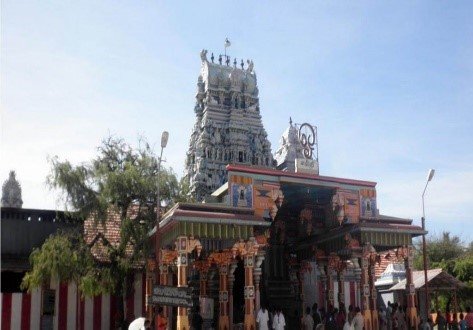

Day 01: Arrival and transfer to Negombo for 01 night
Activities: Overnight stay in Negombo
Day 02: Arrival and transfer to Trincomalee for 02 nights
Activities: Visit the Munneswaram Temple en-route
Visit the Manawari Temple en-route
Visit the Koneswaram Temple
Enjoy the beach of Trincomalee
02 nights stay in Trincomalee
Day 03: After breakfast transfer to Kandy for 01 night
Activities: Visit the Sigiriya Rock fortress en-route
Visit the Temple of Tooth Relic
Visit the Seetha Kotuwa
Watch the Cultural Dance show
City tour of Kandy
Overnight stay in Kandy
Day 04: After breakfast transfer to Nuwara Eliya for 01 night
Activities: Visit Sri Batha Hanuman Temple
See the Ramboda Waterfalls
Visit Sita Amman Temple
See the Hanuman Footprint
Visit the Gayathri Amman Temple
Overnight stay in Nuwara Eliya
Day 05: After breakfast transfer to Colombo for the final night
Activities: Visit the Pinnawala Elephant Orphanage en-route
Visit the Kelaniya Temple
Visit the Anjeyyar Temple
Overnight stay in Colombo
Day 06: Afternoon check out from the hotel and transfer to airport – End of Tour
Descriptions of places
Munneswaram Temple
Munneswaram temple is an important regional Hindu temple complex in Sri Lanka. It has been in existence at least since 1000 CE although myths surrounding the temple associate it with the popular Indian epic Ramayana, and its legendary hero-king Rama. The temple is one of the ancient Pancha Ishwarams dedicated to Shiva in the region. The temple complex is a collection of five temples, including a Buddhist temple. The central temple dedicated to Shiva (Siva) is the most prestigious and biggest, and is popular amongst Hindus. The other temples are dedicated to Ganesha, Ayyanayake and Kali. The Kali temple is also popular with Buddhists, who frequent the complex. Post-19th century, most of the devotees of all temples in the complex belong to the majority Sinhala Buddhist ethnic group; the temples, excluding the Ayyanayake and the Buddhist temple, are administered by families belonging to the minority Hindu Tamils.
Manawari Temple – Manavari Kovil is a Hindu temple 9 kms north of Chilaw. It’s a typical Tamil temple but of significance for Hindu pilgrims from India who travel along the Ramayana trail to visit places connected to Lord Rama. Manavari was the first place where Rama installed a Lingam. This was a remedy to Lord Shiva after commiting the worst possible crime in Hinduism, Brahmincide, by killing King Ravana, who had abducted Rama’s consort Shiva. Ravana was a Brahmin. The Shiva-Lingam in Manavari is called Ramalingam, as it was erected by Lord Rama. There are only two Lingams in the world named after Lord Rama, the other one being that of Rameshwaram in India, the most sacred place in Tamil Nadu. A Ramalingam is an extraordinary object of worship in Hinduism, as Rama is an incarnation of Vishnu and a Lingam is a representation of Shiva, Vishnu and Shiva being the highest gods of different groups of Hindus. Usually, in Vishnuism, Vishnu does not venerate Shiva. He does so as Rama, as told in the Vishnuite Ramayana epic, because the sacrilege of Brahmincide was indespensible to restore the order of the world by freeing Sita and returning to rule in Ayodhya. The erection of the Lingam as symbol of Rama’s devotion to Shiva hence is an extraordinary event in Hindu mythology.
Koneswaram Temple – Koneswaram temple of Trincomalee is an Hindu temple in Trincomalee, Eastern Province, Sri Lanka venerated by Saivites throughout the continent. It is built atop Swami Rock, a rocky promontory cape overlooking Trincomalee, a classical period harbour port town. The primary deity is the Hindu God Lord Shiva in the form Konesar. At its zenith, the Konesar temple was the main shrine of the Trincomalee Koneswaram Temple Compounds, one of three ancient connected Hindu temples on Swami Rock with a considerably sized Gopuram. This temple stood distinctly in the middle of the cape, at its highest eminence. The other two connected temple shrines of the Koneswaram complex, to deities Ganesh, Vishnu (Thirumal), Ambal-Shakti and Murukan stretched across the cape to its extremities. The complex has laid in ruins, been restored, renovated and enlarged by various royals and devotees throughout its history. Heralded as one of the richest and most visited temple compounds in Asia, Koneswaram became one of the most important surviving and influential structures of the classical Dravidian architectural period by the early 17th century.
Sigiriya Rock Fortress
Rising dramatically from the central plains, the enigmatic rocky outcrop of Sigiriya is perhaps Sri Lanka’s single most dramatic sight. Near-vertical walls soar to a flat-topped summit that contains the ruins of an ancient civilisation, thought to be once the epicentre of the short-lived kingdom of Kassapa, and there are spellbinding vistas across mist-wrapped forests in the early morning.Sigiriya refuses to reveal its secrets easily, and you’ll have to climb a series of vertiginous staircases attached to sheer walls to reach the top. On the way you’ll pass a series of quite remarkable frescoes and a pair of colossal lion’s paws carved into the bedrock. The surrounding landscape – lily-pad-covered moats, water gardens and cave shrines – only add to Sigiriya’s rock-star appeal.
Kandy City & Lake – Kandy is a major city in Sri Lanka, located in the Central Province, Sri Lanka. It is the second largest city in the country after Colombo. It was the last capital of the ancient kings’ era of Sri Lanka. The city lies in the midst of hills in the Kandy plateau, which crosses an area of tropical plantations, mainly tea. Kandy is both an administrative and religious city and is also the capital of the Central Province. Kandy is the home of The Temple of the Tooth Relic (Sri Dalada Maligawa), one of the most sacred places of worship in the Buddhist world. It was declared a world heritage site by UNESCO in 1988. The city and the region has been known by many different names and versions of those names. Some scholars suggest that the original name of Kandy was Katubulu Nuwara located near present Watapuluwa. However the more popular historical name is Senkadagala or Senkadagalapura, officially Senkadagala Siriwardhana Maha Nuwara (meaning ‘great city of Senkadagala of growing resplendence’), generally shortened to ‘Maha Nuwara’. According to folklore this name originated from one of the several possible sources.
Pinnawala Elephant Orphanage
The Pinnawala Elephant Orphanage is situated northwest of the town of Kegalle, halfway between the present capital Colombo and the ancient royal residence Kandy. It was established in 1975 by the Sri Lanka Wildlife Department in a 25 acre coconut property adjoining the Maha Oya River. The orphanage was originally founded in order to afford care and protection to the many orphaned Elephants found in the jungles of Sri Lanka. In 1978 the orphanage was taken over by the National Zoological Gardens from the Department of Wildlife. A captive breeding program was launched in 1982. Since the inception of the program over 20 elephants have been bred here. The aim of the orphanage is to simulate a natural habitat to these elephants. However, there are some exceptions: the elephants are taken to the river twice a day for a bath.
Seetha Kotuwa – This is the place where the city of Lankapura once stood. The city had a beautiful palace for queen Mandothari surrounded by waterfalls, streams and varieties of flora and fauna. Seetha Devi was kept in this palace until she was moved to Ashoka Vatika. Seetha Kotuwa means Seetha’s fort and got its name because of Seetha Devi’s stay here.
Sri Bhaktha Hanuman Temple – An 18ft statue of Lord Hanuman towers at the entrance of this kovil which is situated in the beautiful Nuwara Eliya. The kovil was built around 1999 and marks its speciality, on having the tallest Hanuman statue in Sri Lanka. The special poojas conducted during the poya days is a grand event during which the statue of Lord Hanuman is extensively decorated with flowers and silk. The celebrations for Hanuman Jayanthi, the birthday of Lord Hanuman, starts here before 10 days and ends in an impressive manner with chariots and parades. One lakh different names of the lord is chanted and poojas are done during the ten days, engulfing spectators in a holy vibe during the period.
Nuwara Eliya – Nuwara Eliya is a city, in the hill country of the Central Province, Sri Lanka. The city name meaning is “city on the plain (table land)” or “city of light”. The city is the administrative capital of Nuwara Eliya District, with a picturesque landscape and temperate climate. It is located at an altitude of 1,868 m (6,128 ft) and is considered to be the most important location for Tea production in Sri Lanka. The city is overlooked by Pidurutalagala, the tallest mountain in Sri Lanka. The city was founded by Samuel Baker, the discoverer of Lake Albert and the explorer of the Nile in 1846. Nuwara Eliya’s climate lent itself to becoming the prime sanctuary of the British civil servants and planters in Ceylon. Nuwara Eliya, called Little England then, was also a hill country retreat where the British colonialists could immerse in their pastimes such as fox hunting, deer hunting,elephant hunting, polo, golf and cricket.
Seetha Amman Kovil
Devotees on the Rama trail or the Ravana trail in Sri Lanka make a stop at this shrine. It’s located in a green valley with a cool stream rushing by just under the Hakgala Rock which some call the Hanuman Rock. The site is rich in legend and folklore. The ancient site had been newly renovated and the temple had been built in the name of Sri Ram, Sri Sita and Bakthi Hanuman. Legend also says that this is the famous “Asoka Wanaya or the Rhododendron garden’ quoted in the epic Ramayana. Sita who was a captive held by Ravana was in an underground cavern further down in the valley, and the lady prisoner developed a rash on her body due to the lack of sun light. Ravana being a medical practitioner realized this and tunneled a passage up to this point where Sita surfaced. Thus the place where Sita saw the sun light came to be known as Sita Eliya, where the temple exists. On the rock adjoining there are two imprints.
Kelaniya Raja Maha Viharya
Being just seven miles from Colombo, Kelaniya Raja Maha Viharaya is the most sought after Temple for the Buddhists in and around Colombo. On the Eighth year after the Enlightenment, the Lord Buddha has visited this sacred site, which had been the Third and the last visit to Sri Lanka by the Gauthama Buddha. Situated on the banks of Kelani River, which is originating from Sri Pada , makes this Temple surroundings attractive for the devotees who come to worship this hallowed land. The original Temple and the Stupa or the Dageba, was built in 5th Century BC, but none of the earlier structure survive today. Mentioned in the Sri Lankan chronicle”Chulavansa” is that, the Kelaniya Temple was five stories high with traditional styling and roofing. It also states that the temple was rebuilt by King Vijayabahu III, (1232-1236) and King Parakrama Bahu II (1236-1270).
Colombo is the commercial capital and largest city of Sri Lanka by population. According to the Brookings Institution, Colombo metropolitan area has a population of 5.6 million, and 752,993 in the city proper. It is the financial centre of the island and a popular tourist destination. It is located on the west coast of the island and adjacent to the Greater Colombo area which includes Sri Jayawardenepura Kotte, the legislative capital of Sri Lanka and Dehiwala-Mount Lavinia. Colombo is often referred to as the capital since Sri Jayawardenepura Kotte is within the urban area of, and a suburb of, Colombo. It is also the administrative capital of the Western Province and the district capital of Colombo District. Colombo is a busy and vibrant place with a mixture of modern life and colonial buildings and ruins. Due to its large harbour and its strategic position along the East-West sea trade routes, Colombo was known to ancient traders 2,000 years ago.
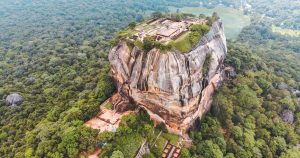
Sigiriya the Lion Rock of Sri Lanka is officially the 8th wonder of the world. It is a rock fortress listed as one of UNESCO’s World Heritage Sites. A popular site among the tourists.
Located in: Matale District
Category: Sights & Land Marks
Entrance:

Kandy was the Capital City of the last remaining Kindom of Sri Lankan King Sri Wickrama Rajasinghe (1592). Many attractions in Kandy and Temple of The Tooth Relic is the main. The famous Train Ride will start from Kandy to Nanuoya / Ella.
Located in: Kandy District
Category: Historic Sites
Entrance: Free

This an artificial lake in the center of the Kandy city. This is an oasis in the middle of the Kandy city. Built-in the 1800s by King Sri Wickrama Rajasinghe the lake has a magnificent view which one would never get tired of.
Located in: Central Province
Category: Nature & Parks
Entrance: Free
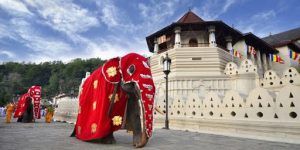
This a temple in the royal palace complex in Kandy which houses the sacred relic of the tooth of the Lord Buddha. In the Buddhist, the culture and the history, sacred relic of the tooth of the Lord Buddha is one of the most religious inheritance. Also, it has a strong history too.
Located in: Central Province
Category: Historic Sites
Entrance: Free

Pinnawala elephant’s orphanage has the largest herd of captive elephants in the world. The orphanage is situated on a 25-acre coconut plantation adjacent to the Maha Oya river.
Located in: Kegalle District
Category: Zoos & Aquariums
Entrance:
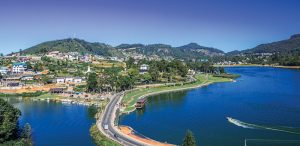
Nuwara Eliya, a city in the hill country is also called Little England due to the similarity between the two climates. The city is all about beautiful landscapes and cool climates. It is also the heart of the tea plantation industry of Sri Lanka.
Located in: Nuwara Eliya District
Category: Sights & Land Marks
Entrance: Free
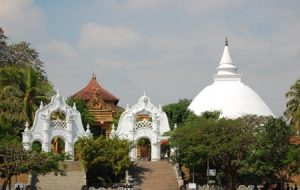
Kelaniya Raja Maha Viharaya is a main sacred and religious temple near Colombo. This temple has a history from 5th century BC. It is believed that Lord Buddha has hollowed Kelaniya during the third visit to Sri Lanka.
Located in: Gampaha District
Category: Sacred & Religious Sites
Entrance: Free

Colombo is the commercial capital of Sri Lanka. Colombo hosts more tourist attractions than any other city in the country. A few of the attractions are National Museum, Galle Face Green, Viharamahadevi Park, Dutch period museum, Dutch Hospital, Federation of Self Employees market in Pettah, Old City hall, House of Geoffrey Bawa. etc
Located in: Western Province
Category: Historic Sites
Entrance: Free
Our specialists are happy to advise you and will help you plan your dream vacation
Request a FREE Itinerary